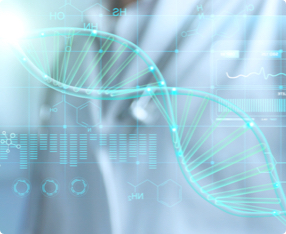Cortical hyperexcitability: tracking a potential ALS indicator
About ALS / Cortical hyperexcitability
How does ALS begin?
It’s a question Professor Matthew Kiernan, Bushell Chair of Neurology at the University of Sydney and Co-Director of Discovery and Translation at the Brain and Mind Centre, thinks about often.
“For patients with a motor neuron disease like ALS, it can seem like it comes out of nowhere,” he says. “I’ve seen patients with no other serious health issues develop severe disability over the course of 18 to 24 months. And it’s heartbreaking when they ask, why me?”
We now know that part of the answer may lie in a genetic link. Up to 10% of all ALS cases—including patients without a family history of the disease—are associated with a known genetic mutation.1
But genes aren’t the only factor that have been linked to ALS, and Prof. Kiernan’s specific focus as a researcher is on the role that cortical hyperexcitability plays in genetic—and non-genetic—forms of the disease.
“Upper motor neuron abnormalities tend to be associated with overactivity of the nervous system,” observes Prof. Kiernan.2 Through understanding more about this overactivity, he believes we can begin to understand more about ALS itself—and, potentially, forge new paths for the future of clinical care.
The excitable brain
Cortical hyperexcitability results from a reduction in, or lack of, short-interval intracortical inhibition (SICI). This lack of inhibition leads to overaction in the upper motor neurons that control human movement. The condition is a known hallmark of ALS,2-4 but the potential for cortical hyperexcitability, according to Prof. Kiernan, is something we are all born with.
“We know that newborns, in their first few weeks of life, have more excitatory pathways in their brains,” Prof. Kiernan says. “Gradually, within the course of a few months, this changes. The process is not very well understood at a biological level, but the brain switches from an excitatory brain to an inhibitory brain. Subsequently, when ALS manifests, patients experience another switch from inhibitory back to excitatory. The disease seems to be, in some way, reactivating these pathways.”5,6 Over time, this hyperexcitability becomes permanent, leading to neuron death and loss of muscle function in patients with ALS.2,4,7
The destruction of upper motor neurons caused by cortical hyperexcitability is thought to be related to the ALS symptom known as “split-hand syndrome.”2,4
“This is one of the most common presentations of ALS, when the muscle in the first dorsal interossei becomes wasted,”2,4 says Prof. Kiernan. “We're unusual as humans in that we’re the only mammals with a pincer grip. But for as evolved as we are, one of the vulnerabilities in our highly developed motor system—at least when it comes to ALS manifestation—is its large representation in our hand grip function.” This insight is consistent with Prof. Kiernan’s observation about the natural excitability of the brain: in mapping the development of common ALS hallmarks, the trail leads him back to the evolutionary developments and biological processes we’re all born with.
Examining ALS from the inside out
Traditionally, the theory of cortical hyperexcitability in ALS—or any theory about the origins of neuromuscular diseases that hinged on neurology alone—was controversial.
Prof. Kiernan explains: “There was a time when evidence suggested that some sort of toxin was entering patients’ bodies through a neuromuscular junction in the arm or the hand or the foot, from which point it would transfer through to the spinal cord and brain and cause cell death. The idea that the disease began in the brain, then spread in an anterograde fashion through the spinal cord and into the neuromuscular junction, was really an alternative view.”
According to Prof. Kiernan, another hypothesis held that ALS onset was at least somewhat random, and that “upper and the lower motor neurons weren't related. For whatever reason, the disease just kicked off everywhere at once.” This theory never sat well with Prof. Kiernan. “When you think about any biological phenomenon, most of them have an origin. Most things start somewhere.” Prof. Kiernan began trying to pinpoint that “somewhere” by phenotyping patients with genetic ALS.
“We started this project 15 to 20 years ago,” says Prof. Kiernan. “When patients first present, we study their brain and, sure enough, we see hyperexcitability. What we don’t know is when that hyperexcitability began. One of the ways to try to get to the bottom of that is to look at individuals who carry mutations linked to the development of motor neuron disease. We knew these individuals had inherited mutations from birth. And we wondered whether they’d been experiencing cortical hyperexcitability for just as long.”
Genetic mutations and hyperexcitability: uncovering a pattern
Prof. Kiernan and his colleagues have spent a long time investigating the connections between cortical hyperexcitability and genetic ALS mutations, and how those connections might affect disease onset.
“We started by studying families where a genetic ALS mutation was present, but whose members had no manifestation of the disease. And what we discovered was that their cortical function was normal. So then we began studying them longitudinally; they would come back every 6 to 12 months and we'd study their brain function. Eventually, a number of them developed hyperexcitability in their brains. This was followed, 6 to 9 months later, by the development of clinical symptoms.”4,8
Prof. Kiernan and his team saw the pattern: the presence of a genetic ALS mutation is often followed by the development of cortical hyperexcitability, which is generally followed some months later by the onset of ALS symptoms.4,8 “We've seen that hyperexcitability often predates clinical features by a period of 6 to 12 months. This is only an estimate at this point. With better technology, we'll hopefully be able to develop a much more precise understanding.”
The technology Prof. Kiernan and his team rely on to measure cortical hyperexcitability in their lab is known as transcranial magnetic stimulation (TMS). “TMS is noninvasive. We use it to observe the speed of signals traveling through the brain and the spinal cord.3,9 The technology, at this point, doesn’t allow us to go down to a molecular level to observe a single cell. What we’re seeing is more likely a group of neurons that innervate a particular muscle. But it is still quite effective to take measurements in this way. Then, in 6 to 9 months, we observe the same area on the same patients and take the measurement again.”
Prof. Kiernan is adamant about the potential cortical hyperexcitability holds as a measure of disease activity. “We need to understand the biology of this disease very intricately,” he says. “Otherwise, everything else is a shot in the dark. If we can monitor patients’ disease course with measures of cortical hyperexcitability, we may develop a better understanding of the process of the disease itself—and that is an important step to developing new ways of managing genetic ALS clinically.”
References: 1. Roggenbuck J, Quick A, Kolb SJ. Genetic testing and genetic counseling for amyotrophic lateral sclerosis: an update for clinicians. Genet Med. 2017;19(3):267-274. 2. Geevasinga, N, Menon P, Özdliner PH, Kiernan MC, Vucic S. Pathophysiological and diagnostic implications of cortical dysfunction in ALS. Nat Rev Neurol. 2016;12(11):651-661. 3. Vucic S, Rutkove SB. Neurophysiological biomarkers in amyotrophic lateral sclerosis. Curr Opin Neurol. 2018;31(5):640-647. 4. van den Bos MA, Geevasinga N, Higashihara M, Menon P, Vucic S. Pathophysiology and diagnosis of ALS: insights from advances in neurophysiological techniques. Int J Mol Sci. 2019;20(11):2818. doi:10.3390 5. Foerster BR, Pomper MG, Callaghan BC, et al. An imbalance between excitatory and inhibitory neurotransmitters in amyotrophic lateral sclerosis. JAMA Neurol. 2013;70(8):1009-1016. doi:10.1001/jamaneurol.2013.234. 6. Murata Y, Colonnese MT. GABAergic interneurons excite neonatal hippocampus in vivo. Sci Adv. 2020;6(24):eaba1430. doi: 10.1126/sciadv.aba1430. 7. Menon P, Higashihara M, van den Boss M, et al. Cortical hyperexcitability evolves with disease progression in ALS. Ann Clin Trans Neurol. 2020;7(5):733-741. 8. Vucic S, Nicholson GA, Kiernan MC. Cortical hyperexcitability may precede the onset of familial amyotrophic lateral sclerosis. Brain. 2008;131(pt 6):1540-1550. doi:10.1093/brain/awn071. 9. Vucic S, Kiernan MC. Transcranial magnetic stimulation for the assessment of neurodegenerative disease. Neurotherapeutics. 2017;14(1):91-106.
1. Roggenbuck J, Quick A, Kolb SJ. Genetic testing and genetic counseling for amyotrophic lateral sclerosis: an update for clinicians. Genet Med. 2017;19(3):267-274. 2. Geevasinga, N, Menon P, Özdliner PH, Kiernan MC, Vucic S. Pathophysiological and diagnostic implications of cortical dysfunction in ALS. Nat Rev Neurol. 2016;12(11):651-661. 3. Vucic S, Rutkove SB. Neurophysiological biomarkers in amyotrophic lateral sclerosis. Curr Opin Neurol. 2018;31(5):640-647. 4. van den Bos MA, Geevasinga N, Higashihara M, Menon P, Vucic S. Pathophysiology and diagnosis of ALS: insights from advances in neurophysiological techniques. Int J Mol Sci. 2019;20(11):2818. doi:10.3390 5. Foerster BR, Pomper MG, Callaghan BC, et al. An imbalance between excitatory and inhibitory neurotransmitters in amyotrophic lateral sclerosis. JAMA Neurol. 2013;70(8):1009-1016. doi:10.1001/jamaneurol.2013.234. 6. Murata Y, Colonnese MT. GABAergic interneurons excite neonatal hippocampus in vivo. Sci Adv. 2020;6(24):eaba1430. doi: 10.1126/sciadv.aba1430. 7. Menon P, Higashihara M, van den Boss M, et al. Cortical hyperexcitability evolves with disease progression in ALS. Ann Clin Trans Neurol. 2020;7(5):733-741. 8. Vucic S, Nicholson GA, Kiernan MC. Cortical hyperexcitability may precede the onset of familial amyotrophic lateral sclerosis. Brain. 2008;131(pt 6):1540-1550. doi:10.1093/brain/awn071. 9. Vucic S, Kiernan MC. Transcranial magnetic stimulation for the assessment of neurodegenerative disease. Neurotherapeutics. 2017;14(1):91-106.







